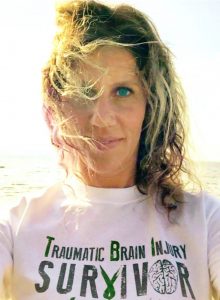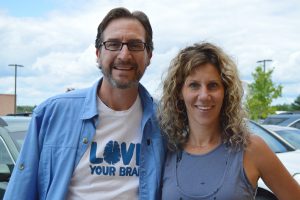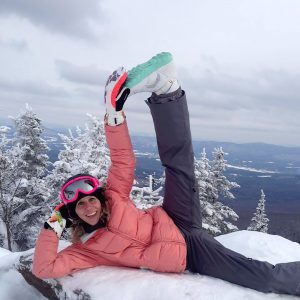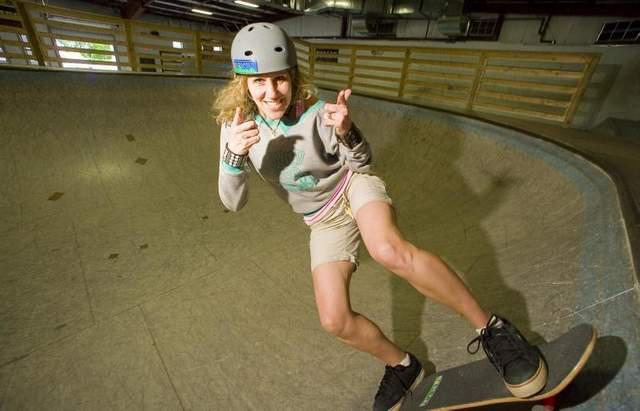Regaining Consciousness
I first met Hannah Deene Wood in South Burlington in 2014. My son, then 6, was gearing up to ride a skateboard as a guest at a birthday party at Talent Skatepark & Shop, which Hannah co-owns. She patiently showed him how to put a helmet on correctly and how to strap it to ensure the fit was secure.
I was merely a parent chaperone, hunkered down with some work while the kids rode the ramps.
Weeks later, I saw that Hanna was part of Brainfarmers, a Vermont City Marathon team running to raise money for traumatic brain injury. Snowboarder Kevin Pearce, who grew up in Vermont, was also running. Pearce had suffered traumatic brain injury too, the result of a horrific crash he had in Utah while training for the 2010 Vancouver Winter Olympics.

I hadn’t trained and was in no shape to run myself. But I donated to the cause because, like Hanna, I had suffered a traumatic brain injury (TBI).
It was early afternoon in August, 2012, when I climbed an extension ladder to try to get our house cat out of a maple tree. Instead, I fell from the tree or ladder—I am not sure which.
Apparently, in the hospital, I was interacting with doctors and pulling out IV tubes. I was complaining of pain in my right wrist, my medical records show. It turns out, I damaged my right wrist, I suppose bracing or protecting my body during the fall. I don’t remember falling. I don’t remember voices asking me if I was okay, or my wife splashing me with water to wake me up. I don’t remember being intubated, or the ambulance ride to the nearest hospital in Littleton, N.H., or the helicopter ride to Dartmouth-Hitchcock Medical Center. I remember nothing.
The brain is us, our essence, who we are. It’s a mass of nerve tissue (neurons with interconnected laments called dendrites and axons and glial cells) and blood vessels and is awash in chemicals and proteins and it blossoms out from the spinal cord.
The results of the processes of the brain determine our personality and mental ability, our cognition, our intelligence. It’s an amazing, remarkable, incredible, truly miraculous organ.
An adult human brain weighs about 3.5 pounds and, on average, is about 2 percent of our body’s weight. Yet it accounts for all of our performance abilities and e orts and peculiarities and individualities and brilliance. The brain is our totality.
As a neuropsychologist said to me, “The brain affects everything.”
I had truly never thought about that until I was 44 years old and woke up (my term for regaining consciousness) after almost three weeks of nothingness. I remember going up the ladder—and then I woke up almost a month later. I do remember some vivid dreams, mainly of water and water scenes such as fly-fishing. I grew up on a lake, I love to fish, and I’ve spent much of my career producing fly-fishing magazines. These images were safe and familiar to me, or they were to my brain.
These memories reside in my long-term memory bank, stored and awaiting recall when needed. I needed them in the summer of 2012 as I wasn’t laying down new memories: my brain simply wasn’t capturing any. I have no memory at all from the afternoon of Aug. 14 to sometime on Sept. 3 of that year.
I know now that I was lucky. No, I was blessed, somehow and for some reason. Destiny means “the seemingly inevitable or necessary succession of events.” I was meant to write about my fall, to try to help support others with TBI, and to educate people about avoiding the risks that can lead to head or brain injuries. That summer I met Hannah, I was at work on a book about my brain injury, continuing recovery, and the discoveries I made and wanted to share about the function and processes of the human brain
Hannah has a glowing personality and an indomitable spirit. She’s cool, fun, and engaging. She was inspiring, and I featured her story in a chapter titled “Brain Injury Survivor Stories” in my book, which was published last spring, Traumatic Brain Injury Handbook: How a Near-Death Fall Led Me to Discover a New Consciousness.
Writing my book was an effort to offer some assurance and hope to caregivers and patients—not that I’m a perfect patient, far from it—that this is an injury from which we can recover. A longtime journalist, I wrote the book because that was the best way I knew to share current research with others.
Hannah was determined to show the positive outcomes of brain injury, and how we can not only survive, but also thrive. That was her theme at the 28th Annual Vermont Brain Injury Conference, held at the University of Vermont campus in Burlington on Oct. 5.
As keynote speaker, Hannah Deene Wood was a force of nature. She talked animatedly about all the ways people can persevere and work at finding their better selves in the “new normal,” as the aftermath of brain injury often becomes known for the survivor.
I’ve found this a different world from what I knew for most of my pre-injury life. Simple tasks that for 44 years I took for granted, such as remembering song lyrics or even recalling the day’s grocery list, are challenging now. If I don’t write down the list, it’s often gone. I need a few beats, too, before I can fully process and answer a question. It’s different, often frustrating not to recall one’s family grocery list, but I adapt and get on with life. I often think of this as a consequence of aging—it’s similar.
“It’s okay,” Hannah said reassuringly several times to the audience of health professionals, care-givers, and those who’ve had TBIs in her speech at the conference. “You got this, you can do it.”
Hannah told me she always thought of herself as a humanitarian—caring, loving, reaching out to others is what fills her up the most. Her motto is, “As the giver, I am the receiver.”

After attending college at UVM, Hannah managed a skateboard shop in Burlington and customers kept telling her that the city needed an indoor skate park. One night, she met a manager of a skate shop from Massachusetts and they started talking; he designed and built skate parks professionally. Drawn together by their similar life interests, they ultimately decided to team up on a skateboard business in South Burlington, which they called Talent Skatepark & Shop.
“We had just signed the lease at Talent and got our loan in 2001, and I was so excited. There was a wallpaper border at the top of a wall and I wasn’t going to open with that ugly wallpaper up there. The ladder was eight feet and it read ‘do not stand’ on one step but there were two more steps above that. I mean, what are the steps doing there if you can’t stand on them? And the top was big enough to stand on. I remember thinking, ‘I’m going to get so much done while (Dave’s) gone.’”
Dave Wood was in Peabody, Mass., building a skatepark. At that time, he was Hannah’s fiancée and now is her husband. “I stood up there (on the ladder). I had an iron and scraper and I was heating the wallpaper and scraping and something happened,” she says. She fell on her left side on the cement floor below.
She was taken to Fletcher Allen Health Care (now the University of Vermont Medical Center). “I had traumatic brain injury on the left side and I had shattered my collarbone,” she says. She was put into a medically-induced coma for a week and a half. Her brain was swelling badly.
“I was intubated and I pulled out the tube 24 times and I destroyed my left vocal cord. That’s why my voice is a little bit weird,” she says. Her mother said she was like a circus contortionist because she would “manipulate, grab and pull” to remove the tube while she was restrained.
She was moved to Fanny Allen rehabilitation hospital in Colchester, the town where she grew up. She was put on anti-seizure and anti-depression medications, and “probably pain stuff,” she says. She stopped taking it. “I didn’t want to be on any of it, because I didn’t think anything was wrong with me,” she says. The doctors wound up putting the meds into soup, and she ate that. She kept thinking she shouldn’t be in the hospital and, like many brain-injury patients, didn’t understand her circumstances.
“I had an escape route that I can still see when I go over to Fanny Allen. If I shimmied down the window and there was enough of a ledge, I could edge my way over to the at roof. And there was a pole, and if I could get to that pole, I was gone. That’s when they started locking me in my bed,” Hannah says.
She was placed in a cage bed, and she said she would kick the bed the whole night shouting “get me out of here.” (Full disclosure: I had a similar escape plan when I was at Fanny Allen. The brain’s amygdala sends the fight or flight impulse—and I wanted to flee.)
Because every brain is different, cognitive recovery is different for every patient. Hannah began work on speech pathology and cognitive therapy—in other words, recapturing daily life skills. When she was released from the hospital, she went back to work at Talent immediately. “I think I got out November 23 and we opened Talent December 21, the goal was to get it opened before Christmas,” she says.

She and Dave married in 2002 and they have two daughters. “In raising them, the empathetic side of me is what I focus on— sharing the caregiver side,” Hannah says. “I’m the giver, and I receive. Like, when I donate blood, that’s the greatest feeling, it fills me to be brim, I’m high as a kite. My feeling then is: Hey, I just saved three people.”
Kevin Pearce was one of the skateboarders riding at Talent. He is a former top snowboarder who, after his accident and TBI, co-founded LoveYourBrain Foundation with his brother Adam.
Hannah had her accident in 2001, Kevin’s crash happened in 2009, and then they reconnected. After they did, Hannah did a website search on the subject “head injuries” and this time one of the search results was the Kevin Pearce Fund with information about LoveYourBrain education and outreach campaigns.
“All of a sudden, you could Google ‘head injuries’ and it wasn’t ‘you’re over, you’re done’ and all that negative stuff. I fell so madly in love with LoveYourBrain because it is what survivors need to thrive! As a head-injury survivor and the owner of a skate park, I probably sell as many helmets as anyone in the state of Vermont. LoveYourBrain is perfect,” she declares. “Love is everything.”
Hannah has spent much of the past 15 years helping inspire others—such as she did at the October Brain Injury Conference. “Because we live in this McDonald’s society, we all want everything to happen so fast,” she said. “I think with my brain injury, it’s gone in peaks and valleys. I’ve gone through weird slumps. I’ve had deep depression and that’s part of a brain injury,” Hannah says. “Not that my path has been so nasty, because it hasn’t been.”
Through the skate park, Hannah is surrounded by the brightness and optimism of youth. Plus, she continued: “I escape through Zumba—it saved my life. I needed some women in my life, because skateboarding is all about little boys and their dads bringing the little boys to skateboard. Now that’s changing, girls are coming and that’s great. But I needed something to get me feeling alive. I went into a Zumba class, and the music started, and you have to move your body to the beat. That is so good for the brain. I became addicted to it. Everybody loves music and music is so healing and brings out a picture of that inner joy.”
I spoke with her before the conference and she told me, “My brain is focused on figuring out how to deliver what I want to share with people. My focus is to keep moving forward and to challenge myself.”
This year, for example, she participating in an event called Over the Edge to support the Flynn Center in Burlington, during which she rappelled down the side of the Courtyard Marriott. “It was amazing, and I’m so thankful I did it,” she said.
She continued: “You have to survive your injury, but you also have to take it that next step and thrive with it. You can’t be complacent in your ‘new you,’ so to speak. You’re not the same person that you were— but that’s not a bad thing. You have to thrive with your injury, and move forward and celebrate life.”
At Talent, Hannah sells a lot of helmets. “It’s absolutely bewildering to me that people dig out helmets from past years, it’s unbelievable what bad shape the helmets are in. I say, ‘Hey, hold on a second, take a look,’ and you see that the helmet is not doing its job, which is to protect your ‘hard drive,’ the most important job a helmet can have. People are receptive to that,” she says.
“For me, selling helmets is so rewarding,” she continues. “It’s a gift to be able to t someone, knowing that the helmet is doing its job and they’re protected. I don’t like people thinking that buying a helmet can be a gift, because it’s not, it’s a necessity. They shouldn’t have to give up their birthday gift to get a helmet. It’s a lesson when a parent says: ‘I love you, I want you to love you, here’s a helmet to take care of yourself.’ It’s all preventative, telling them how to wear their helmet and why to wear their helmet, and they’ll listen.”
“And definitely having my story helps.”
Joe Healy is the author of the 2016 book, Traumatic Brain Injury Handbook: How a Near-Death Fall Led Me to Discover a New Consciousness. He lives in Waterford, Vt.

